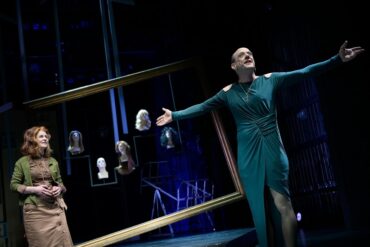Margaret Atwood’s The Testaments is more than a worthy succession to the iconic The Handmaid’s Tale: extremely well composed, featuring interesting characters and full of suspense. What’s more, in times of rising extremist political forces it reminds us of the power of reading.
By Hanna Sellheim
Picture: Books Door Entrance von ninocare via Pixabay, Pixabay-Lizenz
As a grad student of literature, reading has lost some of its magic. I remember the nights I spent with a book in hand as a child: There was a certain sense of forbidden pleasure in spending hour after hour under the covers, turning page after page, knowing that I would be tired the next day, but also certain that the sleep deprivation would be worth finding out what happened next. Only one more chapter, then I’ll sleep, I’d tell myself, only to keep reading after that. A decade later, reading has become somewhat more laborious, work rather than leisure. Don’t get me wrong, of course I still enjoy books. But with most of my reading being mandatory, it happens more often that I find myself setting goals instead of indulging in the process as I used to.
Margaret Atwood’s The Testaments, the long-awaited sequel to her dystopian classic The Handmaid’s Tale from 1985, is one of those books that sparked pure joy in me, just like when I was a child. I had assignments due, I had other books to finish before class, I had to leave the house to meet friends, it didn’t matter ̶ I kept reading. Initially, my expectations had not been high. Of course, it made sense for Atwood to publish a sequel to her most famous work following the hype around the series and the popularity of Handmaids-themed protests against Trump. I expected a hastily constructed narrative whose only purpose was to make profit out of a revival of Gilead by locating it in the here and now. I was wrong.
In The Testaments, Atwood once more exhibits her extraordinary talent as a story-teller, her keen eye for construction, her ability to express myriads by saying very little. What made it impossible for me to put the book down was simply the fact that it was so thrilling. Atwood knows exactly when to employ cliffhangers, where to keep her readers guessing and how to tease them with subtle prolepses. Her composition is exquisite: Confronted with three different female voices and their accounts of Gilead, we learn more about the classes of the state we haven’t gotten to know extensively in The Handmaid’s Tale: the Wives and the Aunts.
Three Distinct Voices from Gilead
15 years after the events of the first novel, we meet three generations of Gilead women: Agnes, who has been kidnapped by the rising regime as a small child and has grown up inside the theocracy. Daisy, who is living in Canada and hence provides an outside perspective. Aunt Lydia, whom we already know from Offred’s account and who played a crucial part alongside the commanders in building the state – however not as voluntarily as it seemed in The Handmaid’s Tale. Their voices are distinguished and well-developed characters, their slightly different use of language makes them believable. Their accounts are labeled as Transcript of Witness Testimony 369A respectively B and The Ardua Hall Holograph. This marking prefigures that Gilead is, after all, doomed to fail, which of course we already knew from the ending of The Handmaid’s Tale that showed a discussion of the theocratic society by historians some hundred years later.
For me, it had been a while since I had left Gilead. I had read The Handmaid’s Tale on a bumpy road trip to Berlin when I was seventeen and loved it but, mistrusting the hype, I hadn’t watched the series, so my recollection of the events was foggy. But even with no or little knowledge of the original story, The Testaments can be read as an autonomous narrative. If you do have the knowledge, parts of it are predictable. A little calculation makes it possible to see the revelations concerning the relations of two main characters and their connection to the first book coming. This also takes away the ambiguity and open-endedness that distinguished the ending of The Handmaid’s Tale. That, however, is admittedly something a sequel is ultimately for.

Margaret Atwood
The Testaments
Penguin RandomHouse: New York 2019
432 Seiten, 16,95$
What makes Atwood’s writing unique is her complete avoidance of over-explication. The system of Gilead is never exhaustingly described, as the genre of utopia and dystopia sometimes tends to do – already its eponymous work, Thomas More’s Utopia, is a lengthy description of a state that completely lacks any narrative elements, much less an arc of suspense. Instead, The Testaments can be understood in its entirety by carefully collecting textual clues and reading between the lines. It is a form of narration that challenges its readers without confusing them, a perfect balance that is hard to attain but which Atwood excels at. Occasionally, she plants slight hints that make readers wonder about everything that is not being said. For example: why does Aunt Lydia admire Commander Judd’s collection of »Doré’s Inferno, Dalí’s Alice’s Adventures in Wonderland, Picasso’s Lysistra«? Does this mix-up of painters and writers merely show Aunt Lydia’s lack of cultural knowledge? That would be puzzling since, as a former judge, her cultural capital should be sufficient to correctly place Picasso. Or does it reveal something about the workings of Gilead’s propaganda machine? We are not supplied with an answer, so we have to keep thinking for ourselves.
Aunt Lydia: Heroine or Villain?
With Aunt Lydia, Atwood creates an extraordinarily interesting character. In the first book she seemed the perfect antagonist to Offred1Of course, the patronymic denomination Offred should be perceived critically and not be confused for an individual name. However, I have chosen to use it in this article as the text of The Handmaid’s Tale offers no distinct clue that the name of the protagonist is indeed June, as the series suggests.: a true believer, determined to do anything to secure the Gilead system. The Testaments, which contain a sort of diary of hers, complicate her character by telling her backstory. Now, she appears highly ambiguous, thus encouraging moral discussions: Is it better to radically object to a totalitarian regime and get killed in the process without changing anything, or to play along in order to at least better the situation for some people even though that means becoming complicit in the regime’s misdeeds? For the reader, Aunt Lydia’s decisions are comprehensible although she is certainly not depicted as morally virtuous, making them question their own hypothetical choices in the same situations.
As always, Atwood’s use of irony is virtuosic. Not only Aunt Lydia’s play with nuances of meaning in her power struggles with Commander Judd and Aunt Vidala makes for a true delight while reading:
»It would be even more efficacious if I could announce her betrothal to myself, and have the subsequent wedding ceremony broadcast. […]«
»Brilliant, as usual,« I said. »But you are married.«
»How is the health of my Wife?« he asked, raising his eyebrows reproachfully.
»Better than it was,« I said, »but not as good as it might be.« […] Dislikeable though Shunammite may have been as a schoolgirl, I have no wish to have her join Judd’s Bluebeard’s chamber of defunct brides. She is in fact making a recovery; however, her terror at the prospect of returning to the loving arms of Judd is impeding her progress. »I fear she will have a relapse,« I said.
He sighed. »I will pray for her release from suffering,« he said.
»And I am sure your prayers will be answered soon.« We gazed at each other across my desk.
»How soon?« he could not resist asking.
»Soon enough,« I said.
Especially in the last chapter ̶ which, once again, frames the events from a historical perspective ̶ Atwood shows how well acquainted she is with academic jargon and how perfectly she can parody it – while also pointing the finger at the latent sexism that still remains even after the end of Gilead:
PIEXIOTO: Thank you, Professor Crescent Moon, or should I say Madam President? We all congratulate you on your promotion, a thing that would never have happened in Gilead. (Applause.) Now that women are usurping leadership positions to such a terrifying extent, I hope you will not be too severe on me. I did take to heart your comments about my little jokes at the Twelfth Symposium – I admit some of them were not in the best of taste – and I will attempt to not reoffend. (Modified Applause.)
Still Relevant, Still Complex
Setting the story 15 years after its precursor’s plot, Atwood does not forcibly make it more modern. Rather, we see a plausible development in Gilead: Having produced its first generation of children with Handmaids, these are no longer of pressing need. Instead, a new disturbing practice has been established: forced child marriages. Furthermore, Atwood now and then subtly nods to the real political present, for example when mentioning the climate protest going on in Canada. She also ironically refers to the hype surrounding the Handmaid’s Tale TV show and criticizes it by having Professor Pieixoto call out the »Period Costume Re-enactment Day« at which people »[got] carried away«. Knowing the novel’s context, one cannot help but to think of the outrages the Handmaids hype has produced, such as Kylie Jenner’s theme party or wedding photos in front of a recreation of the Hanging Wall.
What remains from the first novel is its awareness of the complexity and capability of differentiation. Atwood never claims that the world before Gilead was perfect. She is all too aware of the lack of gender equality in our current society. Nonetheless, she clarifies, the answer to women’s devaluation can never lie in control over their bodies. Gilead’s child bearing procedures that are propagandized to women as a better alternative to a culture that promotes rape appear merely as a consequent result of today’s debates on abortion and the #metoo movement. In this, Atwood proves how accurate her social analysis was already in 1985 and how relevant it still is today.
Still, a blind spot remains: The whole novel is irritatingly heteronormative. Even more so, as the 1985 novel’s and, accordingly, the series’ (which I have started watching in the meantime, once again being proven wrong in my suspicion of the hype) treatment of LGBTQ representation is better, featuring two queer characters in the first episode alone and elaborating on what happens to »gender traitors« in Gilead. It’s obvious that Gilead is organized in a way that only allows for heterosexual relationships, but Atwood completely gives away the opportunity of establishing a subversive queer counter-narrative. Because even if the Gileadian brainwashing and propaganda had been successful in branding same-sex desire as sinful, that certainly would not have made it disappear entirely. And if there is an all-female space set up in the diegetic world (Ardua Hall, the school for Aunts) that houses two close female characters (Agnes and her friend Becka, later Aunts Victoria and Immortelle) already, why not tell a lesbian love story? But instead, we do not meet any queer characters in The Testaments.
Nolite te bastardes carborundorum
Reading The Testaments in 2019 certainly is more uncomfortable than reading The Handmaid’s Tale in 2013, and the questions it rises are of even more current relevance in 2019 than they were in 1985. But while being dunning, the novel still proposes a possibility of resistance against fascism: the act of reading and writing. In a society where women are not allowed to read anymore, the power of books becomes evident. With Agnes, we relive the excitement of learning how to decipher the »black broken insects« into letters and words that have meaning. And this very excitement about reading then is re-sparked by the sheer excellence of the novel.
The Testaments then also is a book about the power of reading, about the knowledge that can be attained through it. Reading becomes an act of empowerment, it’s what helps Aunt Lydia undermine a seemingly stable system. It is her understanding of the rules of language, their ambiguity and her ability to play with them that helps her stand up to Commander Judd. The actual »testaments« prove to be important in their materiality as writing: they are proof of a material truth, thus withstanding postmodern relativism. Just as the (female) body itself, they become evidence of existence and experience, resisting a powerful deceiving narrative. In this way, The Testaments is surprisingly hopeful, with its happy ending perhaps even bordering on kitsch.
Surely, reading and writing alone cannot save us from the real Trumps and Höckes of today that are unsettlingly resembling of the fictional Commanders Judd or Kyle. But it can be a powerful tool in the struggle of not losing one’s voice in the stream of increasingly dystopian-sounding public discourse. If anything, that’s what the emergence of the Handmaids as a cultural symbol in protest movements has proven.






